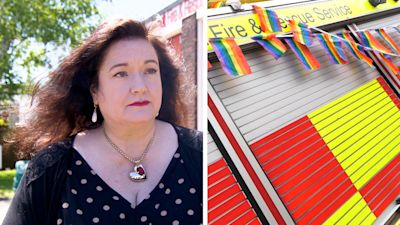Stereotype of firefighters as 'strong straight men' a thing of the past, says chief

Video report on the fire service recognised for its commitment to LGBT inclusion
The stereotypical view that firefighters must be “strong white heterosexual men” is increasingly a thing of the past, according to a long-serving brigade chief.
Ann Millington, chief executive of Kent Fire & Rescue, says there’s been a gradual move away from the “macho, alpha-male” culture that was prevalent decades ago.
She has been speaking to ITV News Meridian after the organisation became the first emergency service in the country to receive the Pride in Care quality standard for its work supporting members of the LGBT community.
Explaining the work involved in achieving the standard, Ann Millington said: “We’ve looked at every single policy in our HR team, every single system that we have, our recruitment, how we do our inductions – you name it, we’ve looked at it – to make sure that everybody can feel that they can bring their whole self to work.
“What we’ve seen as a consequence of that is that we’ve now got people [working for us] who maybe thirty, twenty, even ten years ago, would have felt that the fire service was seen as quite a macho, heterosexual, alpha-male organisation.”
Ann Millington, Chief Executive of Kent Fire and Rescue Service
Ann Millington added: “I think there was a very strong imagery of a white, strong-looking, almost overtly saying ‘I’m a heterosexual man’. I think that had inhibited people feeling they could just come out.
“I think that imagery that was there has gradually eroded and more people joining are saying ‘I identify as something else than a heterosexual man’.
"That has meant increasingly [we’ve been able] to get more people involved in doing what is a very difficult job.
“You want the best in society that you can find and we’re getting that now.”
Home Office figures for 2021 show that 3.4% of firefighters in England were lesbian, gay or bisexual.
This compares to 2.5% in 2016. The data only includes those who stated their sexuality to their employer. Comparable data is not available for trans members of staff.
James Knight joined the service full time six months ago, after many years as an on-call firefighter. He said he initially had reservations about telling his colleagues he was gay.
“I didn’t want it to define my career,” he explains. “At the start I wasn’t as open but I wish I had have been because then you’re honest to yourself.
“It’s really important, as firefighters, that we are here to represent the community we serve.
"That community is made up of all sorts of different people, with different backgrounds and different stories, it’s really important that the fire service mirrors that.”
James Knight shares his experience of being gay in the fire service
Awarded by national charity, Opening Doors, the Pride in Care standard is given to organisations that commit to strengthening their inclusion of LGBTQ+ people over 50.
One of the initiatives has been a campaign to encourage more people from diverse backgrounds to sign up for home safety visits.
Hilary Cooke, chair of Medway Pride, was involved in spreading the work amongst the LGBT community. She said: “The individuals who came along to carry out my visit were absolutely fantastic. Their main goal is to make sure you’re safe in your own home, whoever you are.”
Staff from Kent Fire & Rescue Service are due to attend LGBT Pride events in the county throughout the summer, with fire stations flying the rainbow flag in June to mark Pride month.